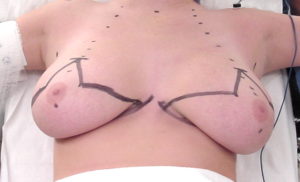The treatment of large breasts with breast reduction surgery is one of the most common plastic surgery procedures performed on women in the United States. It is remarkably effective and every women gets an immediate and significant reduction in their musculoskeletal symptoms.

Think of a breast reduction as two separate operations (breast lift and breast reduction) rolled into one combined procedure. One step is how the skin is reduced and tightened. (breast lift) The second step is how the breast volume is reduced and the nipple preserved. (breast reduction)
Breast Lift Step: By using precise measurements which are marked out before surgery, extra skin is removed similarly to making a cone out of a flat piece of paper. (cut a wedge out of a piece of paper and fold the edges together) A large wedge of skin is removed with the apex of this wedge being at the desired new nipple position. This wedge skin cut out flares outward as it passes below the nipple and each side angles towards the sides of the breast. This skin removal allows the breast to be lift and tightened as it is brought together. This closure (at the end of the operation) creates the classic anchor or inverted T scar that everyone familiar with breast reduction surgery can identify.
Breast Reduction Step: Taking breast tissue is what accounts for the weight reduction of the operation. Think of breast tissue like a mountain with the nipple sitting on top. The size of the breast is made smaller by cutting off the sides of the mountain, but not removing too much that the tissue underneath the nipple is undermined. In most breast reductions, the nipple remains attached to the breast tissue so that it will remain alive and have feeling after surgery.

This approach to breast reduction is the classic and most commonly used inferior pedicle technique. There are other methods of breast reduction and even variations on the inferior pedicle method, but the fundamental principles remain the same.
Dr. Barry Eppley
Indianapolis, Indiana




